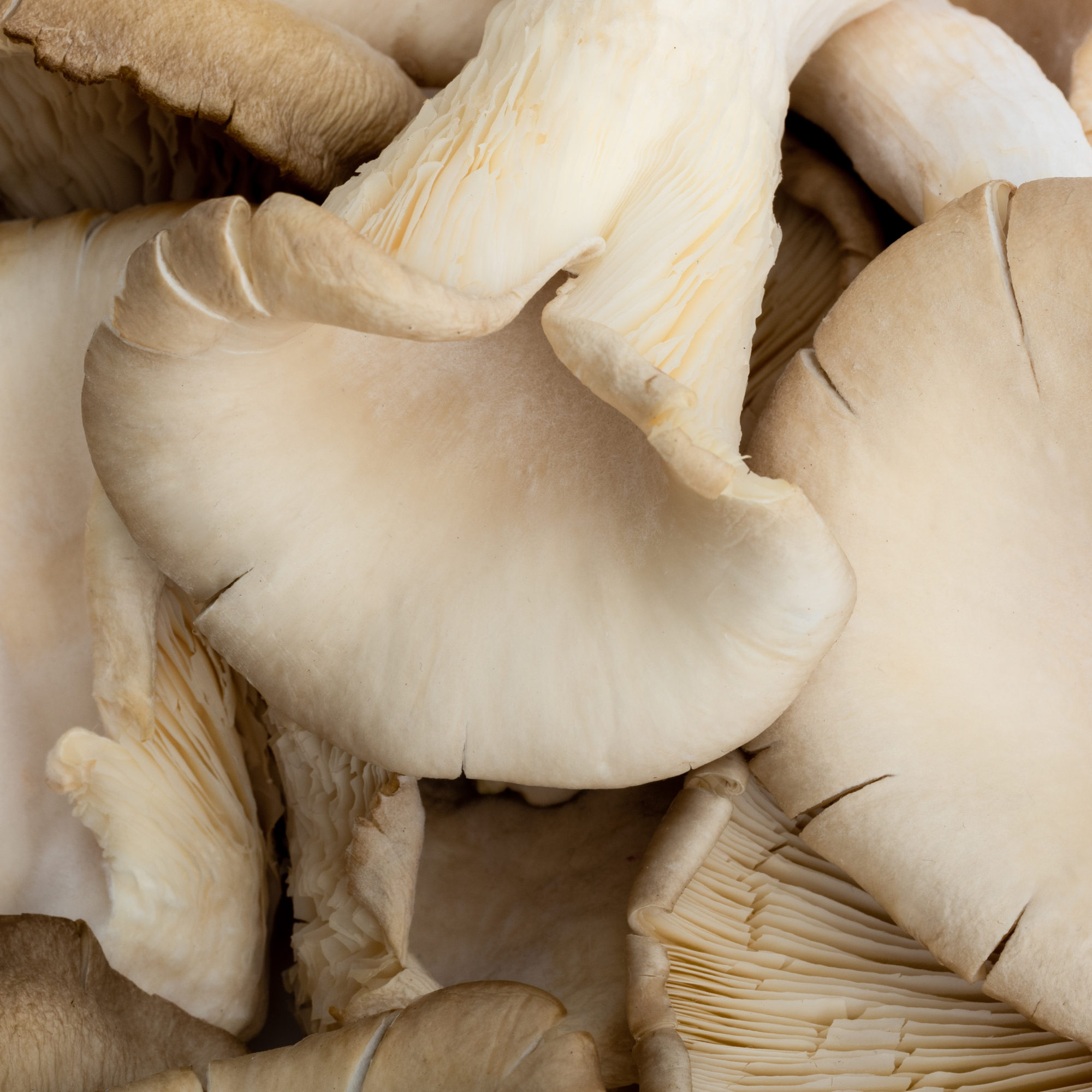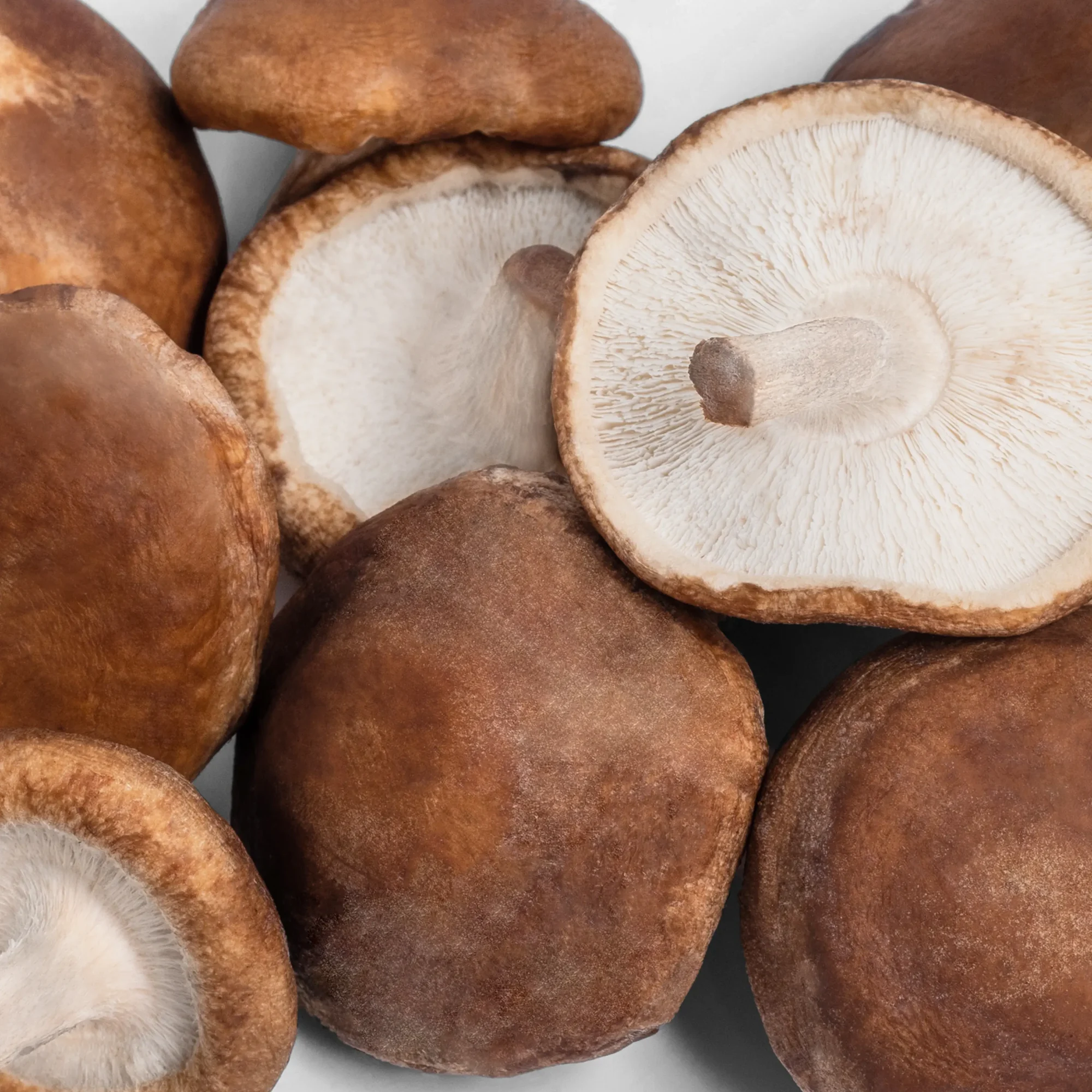European Cultivated Mushrooms offer a diverse array of flavors, textures, and culinary possibilities. Among the most popular varieties are the Agaricus family, which includes both white and brown mushrooms, as well as the Oyster mushrooms, Shiitake, and Pholiota.
White & brown mushrooms
White & brown mushrooms, commonly known as button mushrooms, are widely cultivated and favored for their mild, earthy flavor.
The white variety, with its smooth, ivory cap and firm texture, is a versatile ingredient used in various dishes such as salads, stir-fries, and soups.
On the other hand, the brown Agaricus mushrooms, also known as cremini or portobello mushrooms, possess a deeper, richer flavor and a slightly firmer texture, making them an excellent choice for grilling, roasting, or sautéing.

Oyster mushrooms
Oyster mushrooms, named for their resemblance to delicate oyster shells, come in a range of colors, including white, grey, and pink.
With a subtly nutty and delicate flavor, these mushrooms have a tender, velvety texture that adds a unique touch to both simple and elaborate recipes.
They are often used in stir-fries, risottos, pasta dishes, and even as a meat substitute in vegetarian or vegan preparations.

Shiitake mushrooms
Shiitake mushrooms, originating from East Asia, have gained popularity worldwide due to their distinct umami taste and meaty texture.
These dark-brown mushrooms have a robust, smoky flavor that intensifies when cooked, making them a sought-after ingredient in soups, stews, stir-fries, and sauces.
Caution: shiitake mushrooms should not be eaten raw!

Pholiota mushrooms
Finally, Pholiota mushrooms, also known as chestnut mushrooms, feature a dark brown cap with a mild and nutty taste.
They can be used in various dishes, including sautés, risottos, and as a topping for pizzas or bruschetta, adding depth and richness to the overall flavour profile.

The Health Benefits of Cultivated Mushrooms, for a balanced diet
Although botanists may not classify mushrooms as vegetables, nutritionists recognise their nutritional value. In fact, mushrooms are often included among the fruits and vegetables that should be part of a balanced daily diet. Packed with essential nutrients such as water, fibre, vitamins, mineral salts, trace elements, and proteins, cultivated mushrooms provide a multitude of benefits in various forms—raw, cooked, fresh, or canned. Explore the nutritional highlights of european cultivated mushrooms and discover why they are a valuable addition to a balanced diet.
Cultivated mushrooms offer an array of health benefits, starting with their low-fat and low-calorie composition. They are a source of dietary fiber and protein, with 57% of their calories coming from protein. Additionally, they provide essential nutrients such as potassium, selenium, riboflavin, niacin, folate, pantothenic acid, and biotin. Their high water content, typical of most vegetables, contributes to their low-calorie nature, making them an ideal choice for those seeking to maintain a balanced diet with controlled calorie intake (sources: McCance and Widdowson, EU Guidelines).

Cultivated mushrooms are rich in vitamins, including B2, B3, B5, B7, and B9. These vitamins play vital roles in maintaining bone health, teeth, and muscles, reducing fatigue, supporting normal psychological function, and contributing to the overall functioning of the nervous system (sources: McCance and Widdowson, EU Guidelines). In terms of mineral salts and trace elements, table mushrooms serve as a source of potassium and selenium, while being low in sodium, making them suitable for low-sodium diets. Potassium supports the proper functioning of the nervous system, muscle function, and the maintenance of normal blood pressure. Selenium contributes to a healthy immune system, normal thyroid function, and protects cells from oxidative stress. Moreover, cultivated mushrooms’ high umami levels make them natural flavor enhancers, allowing for reduced salt consumption without compromising taste (sources: McCance and Widdowson, EU Guidelines).
Another remarkable aspect of cultivated mushrooms is their protein content, averaging 1g per 100g, regardless of whether they are raw, cooked, fresh, or canned. This makes them valuable allies for individuals aiming to reduce meat consumption or those following vegetarian or vegan diets. Protein plays a crucial role in promoting muscle mass growth, maintaining muscle mass, supporting normal bone health, and facilitating the growth and development of bones in children (sources: McCance and Widdowson, EU guidelines).
Incorporating European mushrooms into your diet not only supports overall well-being but also offers sustainable alternatives to traditional protein sources, all while enhancing the flavors of your favorite dishes.

Vegan mushroom fajitas
For 4 persons
20 minutes
National Food Based Dietary Guidelines for fruits & vegetables consumption
Mushrooms fully comply with the Food Based Dietary Guidelines developed in each country of the campaign (see below) and participate to a balanced diet.
| Country | Quantitative recommendations | Qualitative recommendations |
| Belgium – Flanders | N/A | Eat a different seasonal vegetable every day. |
| Belgium – Wallonia | 2 portions of fruit and 3 portions of vegetables daily | N/A |
| France | At least 5 portions of fruit and vegetables per day. The recommended serving sizes are 80 g to 100 g. | It is recommended to increase fruit and vegetables consumption, regardless of the initial consumption level. All forms of fruit and vegetables are taken into account: fresh, frozen or canned. Favour fruit and vegetables grown according to production methods that reduce pesticide exposure (precautionary principle). |
| Germany | Eat at least 650 g fruit and vegetables per day in total (at least 400 g vegetables, 250 g fruit). | N/A |
| Hungary | At least 4 servings of fruit and vegetables a day, of which at least 1 is fresh or raw. | Half of what you eat every day should be fruit and vegetables. Eat fresh fruit and vegetables every day. |
| Ireland | 5-7 servings fruit and vegetables a day. Limit fruit juice to once a day with a meal and always choose unsweetened. Notes: Prepare your meals using mostly fresh ingredients and choose fruit, salads and vegetables for snacks. |
Base your meals on fruit and vegetables (up to half your plate or bowl at every meal) and enjoy a variety of colours. |
| Italy | N/A | Eat more fruit, vegetables and tubers. |
| Netherlands | Recommended consumption: at least 200 g fruit and 250 g vegetables daily. | N/A |
| Poland | At least 400 g/d, in at least 5 portions, of which 1 serving can be fruit juice. | Eat fruit and vegetables as often as possible and as much as possible, at least half of what you eat. |
| Spain | 5 servings/d. Notes: In the NAOS Pyramid, fruit & vegetables are the basis of the diet and should be consumed daily. |
N/A |

